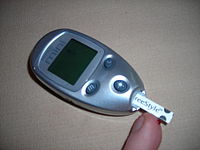
Photo from wikipedia
Introduction This study aimed to evaluate the occurrence of nocturnal hypoglycemia in type 1 diabetes (T1D) based on continuous glucose monitoring (CGM), and to explore the value of capillary glucose profiles… Click to show full abstract
Introduction This study aimed to evaluate the occurrence of nocturnal hypoglycemia in type 1 diabetes (T1D) based on continuous glucose monitoring (CGM), and to explore the value of capillary glucose profiles in assessing the risk of nocturnal hypoglycemia. The study also intended to develop a predictive model to identify people with high risk of nocturnal hypoglycemia. Methods A total of 169 participants with T1D received 3 days of blinded CGM; meanwhile, their self-monitoring blood glucose (SMBG) profiles were recorded. Logistic regression analyses were used to evaluate contributory factors of nocturnal hypoglycemia. Potential indicators were estimated using area under receiver operator curve (AUC) analyses. Results During the retrospective CGM period, 95 (56.2%) participants with T1D reported 238 events of hypoglycemia, and 69 (29.0%) of these episodes occurred during the nighttime. Increased risk of nocturnal hypoglycemia correlated with lower HbA1c, glycated albumin, and mean blood glucose (OR = 0.790, 0.940, 0.651, respectively; P < 0.05) and higher standard deviation, mean amplitude of glycemic excursions, and low blood glucose index (OR = 1.463, 1.168, 4.035, respectively; P < 0.05) after adjustment for age and duration. Of the daily SMBG profiles, fasting blood glucose (OR = 0.643, P = 0.001) and blood glucose at bedtime (OR = 0.851, P = 0.037) were associated with the occurrence of nocturnal hypoglycemia. The BGn model, which was derived from the variation of capillary glucose, could discriminate individuals with increased risk of nocturnal hypoglycemia (AUC = 0.774). Conclusions Nocturnal hypoglycemia constitutes nearly one-third of hypoglycemic events in people with T1D. Strict glycemic control and great fluctuation of glucose are potential contributory factors. Daily SMBG profiles and the BGn model could help assess the risk of nocturnal hypoglycemia in T1D, which may support further development of preventive strategies.
Journal Title: Diabetes Therapy
Year Published: 2020
Link to full text (if available)
Share on Social Media: Sign Up to like & get
recommendations!